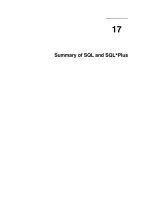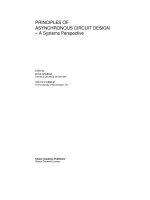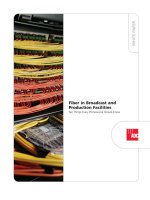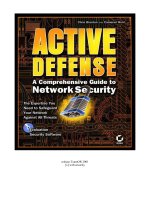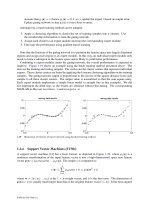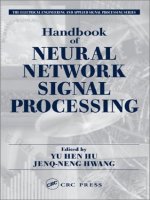Tài liệu Taxonomy of Conflicts in Network Security Policies docx
Bạn đang xem bản rút gọn của tài liệu. Xem và tải ngay bản đầy đủ của tài liệu tại đây (301.21 KB, 8 trang )
1
Taxonomy of Conflicts in Network Security Policies
Hazem Hamed and Ehab Al-Shaer
School of Computer Science, Telecommunications and Information Systems
DePaul University, Chicago, USA
Abstract— Network security polices are essential elements in
Internet security devices that provide traffic filtering, integrity,
confidentiality and authentication. Network security perimeter
devices such as firewalls, IPSec and IDS/IPS devices operate
based on locally configured policies. However, configuring network
security policies remains a complex and error-prone task due
to the rule-dependency semantics, and the interaction between
policies in the network. This complexity is likely to increase as
the network size increases. A successful deployment of a network
security system requires global analysis of policy configurations of
all network security devices in order to avoid policy conflicts and
inconsistency. Policy conflicts may cause serious security breaches
and network vulnerability such as blocking legitimate traffic,
permitting unwanted traffic, and insecure data transmission.
This paper presents a comprehensive classification of security
policy conflicts that might potentially exist in a single security
device (intra-policy conflicts) or between different network devices
(inter-policy conflicts) in enterprise networks. We also show the
high probability of creating such conflicts even by expert system
administrators and network practitioners.
I. INTRODUCTION
With the global connectivity provided by the Internet, net-
work security has gained significant attention in research and
industrial communities. Due to the increasing threat of network
attacks, network security devices like firewalls and IPSec gate-
ways have become important integrated elements not only in
enterprise networks but also in small-size and home networks.
On one hand, firewalls provide the network frontier defense
against attacks and unauthorized traffic by filtering out unwanted
network traffic coming from or going to the secured network. On
the other hand, IPSec devices provides integrity, confidentiality
and authentication of data communication over IP networks.
Deploying firewall and IPSec technology in the network
provides incredible flexibility for customizing the proper pro-
tection for different networks and applications. However, our
study shows that even expert administrators can make serious
mistakes when configuring the network security policy of these
devices. Therefore, unawareness of policy conflict types and the
lack of automated verification of security policies significantly
increase the potential of policy inconsistency and conflicts thus
increasing network vulnerability.
There are many challenges confronting the correctness and
consistency of security policy configuration in enterprise net-
works. First, in a single security device, the ordering of the
policy rules is critically important to determine the underlying
policy semantics. An incorrect rule ordering may obsolete
some critical rules and result in a security hole that can be
a target for a network attack. Second, the interaction between
different network security policies in a distributed network
environment introduces additional challenges. For example,
inconsistent rule matching between two firewalls can result in
illegitimate traffic being allowed into the network, leading to
serious security threats such as denial of service attacks. Also,
incorrect configuration of cascaded IPSec tunnels can lead to
sending confidential data as clear text violating the security
policy. Third, the existence of many action types (e.g., bypass,
discard, encrypt/tunnel, authenticate/transport, etc.) presents
another challenge when analyzing network security policies.
Policy conflicts in IPSec devices may cause either a failure in
establishing secure communication, or degrade the performance
due to performing unnecessary redundant security operations.
Policy conflicts occur due to rule misconfiguration within
a single policy (intra-policy conflicts) or between policies in
different devices (inter-policy conflicts). The successful de-
ployment of network security is dependent on thorough un-
derstanding of the sources of these conflicts, and enabling
automated inspection of security policy rules with minimal
human intervention. The goal of this article is to provide a
comprehensive road-map for researchers as well as practitioners
in the field to study various network security policy conflicts
and misconfigurations in firewalls and IPSec gateways. Our
conflict classification includes both access-lists and map-lists
used respectively by firewalls and IPSec gateways, for both
intra- and inter-policy cases. We also identify the conditions
and the risk of each conflict or misconfiguration, and show
many real examples for illustration. Finally, we briefly describe
our implementation of these techniques in a tool called the
“Security Policy Advisor” for automatic discovery of security
policy conflicts.
Although firewalls and IPSec devices have been deployed for
many years, most of the related research has been focused on
addressing firewall and IPSec implementation and performance
problems. Some related works [4], [7], [11] use a query-based
approach to analyze firewall policies. Other related work [5]
discovers the conflicts of overlapping IPSec tunnels using a
simulation-based technique. To the best of our knowledge, this
is the first study that provides a comprehensive classification
and identification of rule conflicts in network security devices.
The rest of this paper is organized as follows. In Section II
we highlight the main components of network security policies.
In Section III we present our formalization of filtering rule
relations. In Sections IV and V we identify and define access-list
and map-list conflicts, respectively. In Section VI we present an
evaluation and usability study of our proposed conflict analysis.
In Section VII we give a summary of the previous work
related to our research. Finally, in Section VIII we present our
conclusions and plans for future research.
2
Host A1 (1.1.1.1)
Firewall/IPSec Gateway
SG
A
(5.5.5.5)
Firewall/IPSec Gateway
SG
B
(6.6.6.6)
Host A2 (1.1.1.2)
Host A3 (1.1.1.3)
Host B1 (2.2.2.1)
Host B2 (2.2.2.2)
Host B3 (2.2.2.3)
Internet
TCP 1.1.*.* : any 2.2.*.* : 21 discard
TCP 1.1.1.1 : any 2.2.*.* : any bypass
TCP 1.1.*.* : any 2.2.*.* : any protect
TCP 1.1.1.* : any 2.2.2.* : any ESP Tunnel 6.6.6.6 {3DES}
TCP 1.1.1.1 : any 2.2.*.* : any protect
TCP 1.1.1.1 : any 2.2.2.3 : any AH Transport {SHA1}
TCP 2.2.2.3 : any 1.1.*.* : any protect
TCP 2.2.2.3 : any 1.1.1.1 : any AH Transport {SHA1}
TCP 2.2.*.* : any 1.1.*.* : 21 discard
TCP 2.2.2.3 : any 1.1.*.* : any bypass
TCP 2.2.*.* : any 1.1.*.* : any protect
TCP 2.2.2.* : any 1.1.1.* : any ESP Tunnel 5.5.5.5 {3DES}
Fig. 1. Example of a typical Firewall/IPSec configuration. Only hosts A1 and B3 are IPSec capable. Security gateways SG
A
and SG
B
perform both firewall
filtering and IPSec protection operations.
II. NETWORK SECURITY POLICY BACKGROUND
A security policy enforcement point is the network element
that controls the traversal of packets across network segments
based on a given network security policy. These include fire-
walls and IPSec devices, which are installed either at end
hosts or at intermediate network nodes. The network protection
offered by firewalls/IPSec is based on requirements defined
by a security policy established and maintained by a user or
system administrator [8]. In general, packets are selected for
a packet transmission/protection mode based on network and
transport layer header information matched against entries in
the policy, i.e., transport protocol, source address and port
number, and destination address and port number. Each packet
is either discarded, protected and transmitted, or permitted to
flow without protection. The decision is based on the policy
rules that match this traffic. To define traffic protection rules,
we use a generic policy format that resembles the format used
in a wide range of firewall and IPSec implementations [12]. In
this format, the network security policy is composed of two lists
of packet-filtering rules: access list, and map list.
Access list: it consists of ordered filtering rules that define
the actions performed on packets that satisfy the rule conditions.
All traffic is matched against the access rules sequentially till a
matching rule is found. The rules are ordered such that all the
packets in a flow will always trigger the same rule. The rule
determines the required security action, where a protect action
means that the traffic is securely transmitted, a bypass action
means that the traffic is transmitted unsecured and a discard
action means that the traffic is dropped. Such rules are used
in firewall policies to permit or discard traffic, and in IPSec
policies to select the traffic to be protected.
Map list: the rules in this list determine the security
mapping required to protect the traffic selected by the access
list, also based on a set of packet filters. Each rule is given a
priority and the traffic is matched against the highest priority
rule first. Multiple rules can be triggered for the same flow
resulting in applying more than one security transformation on
the same traffic. Such rules are used in IPSec policies to specify
the cryptographic transformation for a specific traffic.
access list := access rule[. . . , access rule]
access rule := order, f ilter, action
filter := transport, src ip, src port, dst ip, dst port
action := protect | bypass | discard
map list := map rule[. . . , map rule]
map rule := priority, filter, transf orm list
transform list := transf orm[. . . , tr ansf orm]
tr ansf orm := sec protocol, encaps mode, parameters
sec protocol := AH | ESP
encaps mode := Transport | Tunnel tunnel dst
Fig. 2. The syntax of network security policy statements.
Firewalls control the traversal of packets across the bound-
aries of a secured network based on the security policy. A
firewall security policy is an access list of ordered filtering rules.
Filtering actions are either bypass, which permits the packet to
enter or leave the secure network, or discard, which causes the
packet to be blocked and dropped. Firewalls are widely used to
protect the network from external attacks like port and address
scanning and denial of service attacks. They are also used to
control the flow of traffic between network segments.
IPSec [9] is one of the most widely used protocols to
provide secure transmission across the Internet. IPSec uses
two security protocols to provide traffic security: Authentica-
tion Header (AH) and Encapsulating Security Payload (ESP).
The AH protocol provides connectionless integrity, data origin
authentication, and an optional anti-replay service. The ESP
protocol provides confidentiality (encryption) and optional con-
nectionless integrity, data origin authentication, and an anti-
replay service. These protocols may be applied individually or
in combination with each other to provide the desired security
services. IPSec operations can be performed either at the traffic
source and destination (transport mode) or at intermediate
security gateways (tunnel mode), in order to allow for source-
based or domain-based security. In transport mode the protocols
provide protection primarily for upper layer protocols without
3
Network Security
Policy Conflicts
Access-list
Conflicts
Map-list
Conflicts
Inter-policy
Conflicts
Nested-
session
Conflicts
Intra-policy
Conflicts
Multi-
transform
Conflicts
Shadowing Redundancy Correlation Exception Shadowing Spuriousness
Partial
Shadowing
Complete
Shadowing
Partial
Spuriousness
Complete
Spuriousness
Fig. 3. Classification chart of network security policy conflicts.
changing the original IP headers. However, in tunnel mode, the
protocols are applied to the entire IP packet and may modify
the source and destination address of the original IP header to
be the intermediate security gateways.
Network security policy rules can be written using the syntax
shown in Fig. 2. The access list is used to define firewall
policies as well as IPSec protection rules, while the map list
is used to define IPSec transformation rules. A source or
destination IP address can be specified as a single value or
a range of values with a common network prefix. A source
or destination port number is given as a single value or an
interval of values. A transform is any cryptographic service that
can be used to protect network traffic. These security services
are practically IPSec AH and ESP either in transport or tunnel
mode along with the cryptographic algorithm and the necessary
cryptographic parameters. Fig. 1 shows an example of a typical
firewall/IPSec policy for outbound traffic. In this example,
security gateways integrate firewall and IPSec functionality. The
policy at each device is defined in terms of the access-list
(upper section) and the map-list (lower section). In our work, we
assume that inbound traffic is matched against a mirror image
of the outbound IPSec policy, where the packet filters for the
traffic source and destination are swapped [12]. The policy in
host A1 requires integrity verification using AH transport for all
traffic flowing to host B3. The policy in gateway SG
A
blocks
FTP traffic from flowing to any host in network B. In addition,
all traffic flowing from network A to network B should be
encrypted using ESP tunneling, except for the traffic coming
from host A1.
In the rest of this paper we proceed with the classification and
analysis of conflicts in network security policies. Fig. 3 shows
the organization of our taxonomy of these conflicts. We divide
the conflicts into two main categories: access-list conflicts that
may exist between the rules in the access policy, and map-list
conflicts that may exist in the map policy. We further classify the
access-list conflicts into two subcategories: intra-policy conflicts
that may exist within a single policy, and inter-policy conflicts
between the policies in different devices. Finally, we identify
the possible policy conflicts in each subcategory.
R
y
Exact matching Inclusive matching Correlation
R
x
R
y
R
y
R
x
R
x
Fig. 4. Different relations between packet filtering rules R
x
and R
y
.
III. MODELING OF RULE RELATIONS
As rules are matched sequentially, the inter-rule relation
or dependency is critical for determining any conflict in the
security policy. In other words, if the rules are disjoint (no
inter-rule relation), then any rule ordering in the security policy
is valid. Therefore, classifying all types of possible relations
between filtering rules is a first step to understand the source
of conflicts due to policy misconfiguration. In this section we
describe all the relations that exist between filtering rules by
comparing the fields of filtering rules. The relation between
field i in rule R
x
and the corresponding field in rule R
y
can
be either equal, subset, superset or distinct. For example, the
IP address 140.192.61.5 is distinct from 140.192.60.5, but it is
a subset of 140.192.61.*. We can then define the filtering rule
relations as follows:
• Exactly matching rules (R
x
=R
y
). Rules R
x
and R
y
are
exactly matched if every field in R
x
is equal to the
corresponding field in R
y
. In the following example, Rule 1
and Rule 2 are exactly matching:
1: tcp 140.192.37.
*
any 61.20.33.
*
80
2: tcp 140.192.37.
*
any 61.20.33.
*
80
• Inclusively matching rules (R
x
⊂R
y
). Rule R
x
inclusively
matches R
y
if the rules do not exactly match and if every
field in R
x
is a subset or equal to the corresponding
field in R
y
. R
x
is called the subset match while R
y
is
called the superset match. In the following example, Rule 3
inclusively matches Rule 4. Rule 3 is the subset match of
the relation while Rule 4 is the superset match:
3: tcp 67.92.37.20 any 61.20.33.
*
80
4: tcp 67.92.37.
*
any 61.20.
*
.
*
80
• Correlated rules (R
x
R
y
). Rules R
x
and R
y
are corre-
lated if at least one field in R
x
is a subset or partially
4
Host A1 (1.1.1.1)
Host A2 (1.1.1.2)
Host A3 (1.1.1.3)
Host B1 (2.2.2.1)
Host B2 (2.2.2.2)
Host B3 (2.2.2.3)
1: TCP 1.1.1.1 : any 2.2.2.1 : any protect
2: TCP 1.1.1.2 : any 2.2.2.2 : any protect
3: TCP 1.1.1.3 : any 2.2.2.3 : any bypass
4: TCP 1.1.1.2 : any 2.2.2.3 : any discard
5: TCP 1.1.1.* : any 2.2.2.2 : any discard
6: TCP 1.1.1.* : any 2.2.2.* : any bypass
7: TCP 1.1.1.2 : any 2.2.2.1 : any bypass
8: TCP 1.1.1.1 : any 2.2.2.* : any discard
Firewall/IPSec Gateway
SG
B
(6.6.6.6)
Firewall/IPSec Gateway
SG
A
(5.5.5.5)
Internet
1: TCP 1.1.1.1 : any 2.2.2.1 : any protect
2: TCP 1.1.1.2 : any 2.2.2.2 : any bypass
3: TCP 1.1.1.3 : any 2.2.2.3 : any protect
4: TCP 1.1.1.2 : any 2.2.2.3 : any bypass
5: TCP 1.1.1.3 : any 2.2.2.2 : any protect
6: TCP 1.1.1.1 : any 2.2.2.3 : any discard
7: TCP 1.1.1.* : any 2.2.2.1 : any protect
8: TCP 1.1.1.2 : any 2.2.2.* : any discard
Fig. 5. Example IPSec access-list policy with intra- and inter-policy conflicts. Solid lines indicate permitted traffic, while dotted lines indicate blocked traffic.
intersects with the corresponding field in R
y
, and at least
one field in R
y
is a superset or partially intersects with
the corresponding field in R
x
, and the rest of the fields are
equal. This means that there is an intersection between the
address space of the correlated rules although neither one
is subset of the other. Figure 4 illustrates the address space
intersection in this case. In the following example, Rule 5
and Rule 6 are correlated:
5: tcp 140.192.37.
*
any 61.20.
*
.
*
0-256
6: tcp 140.192.
*
.
*
any 61.20.33.
*
128-512
• Disjoint rules. Rules R
x
and R
y
are completely disjoint if
every field in R
x
is not a subset and not a superset and
not equal to the corresponding field in R
y
. However, rules
R
x
and R
y
are partially disjoint if there is at least one
field in R
x
that is a subset or a superset or equal to the
corresponding field in R
y
, and there is at least one field in
R
x
that is not a subset and not a superset and not equal
to the corresponding field in R
y
. Rule 7 and Rule 8 in the
following example are partially disjoint:
7: tcp 140.192.37.
*
any 61.20.
*
.
*
80
8: tcp 140.192.37.
*
any 61.20.33.
*
21
IV. CLASSIFICATION OF ACCESS-LIST CONFLICTS
After identifying the possible relations between rules, we are
now ready to study the types of rule conflicts, In this section,
we focus the discussion on the conflicts that may exist between
access list rules. These conflicts may exist between rules in
the same security device (intra-policy conflicts) or in different
devices (inter-policy conflicts).
A. Intra-policy access-list conflicts
It is very common to find filtering rules that are inter-related,
i.e., exactly matched, inclusively matched or correlated. In
this case, different rule orderings may imply different and
incorrect policy semantics (i.e., matching behavior). Thus,
if the related rules are not carefully ordered, some rules
may be concealed by other rules, resulting in an incorrect
policy. In this section, we classify different conflicts that may
exist among the rules in a single firewall or IPSec access policy.
Intra-policy shadowing: A rule is shadowed when every
packets that could match this rule is matched by some preceding
rule with a different action. Consequently, the shadowed rule
will never have an effect in the policy. Typically, rule R
y
is shadowed by rule R
x
if R
x
precedes R
y
and R
x
exactly
or inclusively matches R
y
and the two rules have different
actions. For example, in Fig. 5 Rule 8 in SG
A
is shadowed by
Rule 6 because Rule 6 will match and thereby conceal all the
traffic that would match Rule 8. Shadowing is a critical error
in the policy, as the shadowed rules become obsolete and never
take effect. This might cause a legitimate traffic to be blocked
or illegitimate traffic to be permitted. Therefore, as a general
guideline, if there is an inclusive or exact match relationship
between two rules, any superset (or general) rule should come
after the subset (or specific) rule. It is mandatory to discover
shadowed rules and alert the administrator to correct this error
by reordering or removing the shadowed rule.
Intra-policy correlation: As described in Section III, if
two rules are correlated then there is some traffic that matches
both rules. Thus, if the two correlated rules have different
actions, then the action performed on the traffic is dependent
on the ordering of the two rules. This dependency is not
intuitive and leads to ambiguity in defining the security policy.
A correlation conflict between two rules exists if the rules
are correlated and they have different filtering actions. For
example, a correlation conflict exists between Rule 7 and
Rule 8 in SG
B
in Fig. 5. The two rules with this ordering
imply that all traffic that is coming from 1.1.1.2 and going
to 2.2.2.1 is protected. However, if their order is reversed,
the same traffic will be discarded. Correlation is considered a
conflict warning because the correlated rules imply an action
that is not explicitly handled by the policy. Therefore, in order
to resolve this conflict, the correlation between rules should be
discovered and the user should choose the proper rule order
that complies with the security policy requirements. Otherwise,
unexpected action might be performed on the traffic that
5
action
x
= action
y
action
x
= action
y
x < y x > y x < y x > y
R
x
= R
y
R
y
Redund. R
x
Redund. R
y
shadow. R
x
shadow.
R
x
⊂ R
y
R
x
Redund. R
y
Redund. R
x
except. R
y
except.
R
x
R
y
Legitimate Legitimate R
x
correl. R
y
correl.
TABLE I
INTRA-POLICY ACCESS-LIST CONFLICTS.
matches the intersection of the correlated rules.
Intra-policy exception: Exception rules are very common
in network security policies. A rule is an exception of a
following rule if they have different actions, and the following
rule is a superset match (it could match all packets of the
preceding rule). For example, in SG
A
in Fig. 5, Rule 2 is an
exception of Rule 5. These two rules imply that all the traffic
coming from the address 1.1.1.* to 2.2.2.2 will be discarded,
except the traffic coming from 1.1.1.2. Exception is often used
to exclude a specific part of the traffic from a general filtering
action. This is not in general an error, however, it is important
to identify exceptions because the exception rules change the
policy semantics, which may or may not be desirable. This for
example might cause accepted traffic to be blocked or denied
traffic to be permitted. Thus, this type of conflict is considered a
warning that is important to be highlighted to the administrator.
Intra-policy redundancy: A rule is redundant when every
packets that could match this rule is matched by some other
rule that has a similar action. In other words, if the redundant
rule is removed, the behavior of the security policy remains
unchanged. Rule R
y
is redundant to rule R
x
if R
x
precedes
R
y
and R
y
exactly or inclusively matches R
x
and the two
rules have similar actions. However, rule R
x
can be redundant
to R
y
if R
x
inclusively matches R
y
and there exists no
rule in-between that is an exception or correlated with R
x
.
Fig. 5 shows two rule redundancy examples in SG
A
; Rule 3
with Rule 6 is the first case, and Rule 7 with Rule 6 is
the second. Redundancy is considered a problem in firewall
policies because it increases the policy size and consequently
the search time and space of packet filtering, while it does
not contribute to the policy semantics. Thus, it is important to
discover redundant rules so that the administrator may modify
or remove them altogether. In general, to avoid redundant rules,
a superset rule following a subset rule should have a different
filtering action.
Table I summarizes the conditions of the intra-policy access-
list conflicts. The table shows the type of conflict existing
between two rules with different rule relations and actions.
B. Inter-policy access-list conflicts
Even if every device policy in the network does not contain
any of the intra-policy conflicts described in Section IV-A,
conflicts could exist between policies of different devices. For
example, a firewall might block traffic that is permitted by
another downstream firewall, or an upstream IPSec device might
protect traffic that is not protected by the peer downstream
action
u
/action
d
action
u
/action
d
permit/permit deny/deny permit/deny deny/permit
R
u
= R
d
Legitimate Legitimate Comp. spur. Comp. shad.
R
u
⊂/ R
d
Part. shad. Part. spur. Comp. spur. Part. shad.
R
u
⊃ R
d
Part. spur. Part. shad. Part. spur. Comp. shad.
TABLE II
INTER-POLICY ACCESS-LIST CONFLICTS.
device. In both cases, the traffic will not reach the destination as
it will be dropped by the upstream devices. In this section, we
first define criteria of inter-policy conflicts and then classify the
conflicts that may exist between an upstream and a downstream
access policy for both firewall and IPSec devices.
Referring to Fig. 5, we assume a traffic stream flowing from
sub-domain D
A
to sub-domain D
B
across multiple cascaded
policy enforcement points installed on the network path between
the two sub-domains. At any point on this path in the direction
of flow, a preceding device is called an upstream device whereas
a following one is called a downstream device. Using the above
network model, we can say that for any traffic flowing from
sub-domain D
A
to sub-domain D
B
a conflict exists if one of
the following conditions holds:
1) The most-downstream device permits traffic that is
blocked by any of the upstream devices.
2) The most-upstream device permits traffic that is blocked
by any of the downstream devices.
On the other hand, all intermediate devices should permit/bypass
any traffic that is permitted/protected by the most-upstream
and most-downstream device such that the flow can reach its
destination.
a) Inter-policy shadowing: This conflict is similar to the
one discussed in Section IV-A except that it occurs between
rules in two different policies/devices. Thus, Inter-policy shad-
owing occurs if the upstream policy blocks some traffic that is
permitted by the downstream policy.
There are two cases for shadowing between polices. The
first case occurs if the traffic permitted (or protected) by a
downstream rule, R
d
, in SG
B
is actually discarded by the
upstream rule, R
u
, in SG
A
. In the second case, the traffic
protection is required by R
u
in SG
A
but not by any R
d
in
SG
B
. In IPSec, this causes the security association negotiation
to fail and consequently results in discarding this traffic at the
upstream device. In Fig. 5, Rule 4 in SG
A
and Rule 4 in
SG
B
show an example of the first case. An example for the
second case is Rule 2 in SG
A
and Rule 2 in SG
B
. If the rules
exactly match, then all the traffic permitted by R
d
is blocked
by R
u
, and we have complete shadowing. The two examples
above are considered complete shadowing. However, if the rules
inclusively match, then part of the traffic permitted by R
d
is
blocked by R
u
, and we have partial shadowing. Rule 5 in SG
A
and Rule 5 in SG
B
are an example of partial shadowing.
Shadowing is considered a conflict because it prevents
the traffic desired by some nodes from flowing to the end
destination.
6
TCP 1.1.*.* : any 6.6.*.* : any protect
TCP 1.1.*.* : any 6.6.*.* : any AH Tunnel 7.7.7.7 {SHA1}
TCP 1.1.1.1 : any 2.2.*.* : any protect
TCP 1.1.1.1 : any 2.2.2.* : any ESP Tunnel 5.5.5.5 {3DES}
TCP 1.1.1.1 : any 2.2.2.2 : any AH Tunnel 6.6.6.6 {SHA1}
IPSec Gateway
SG
A
(5.5.5.5)
Host A (1.1.1.1)
Host B (2.2.2.2)
IPSec Gateway
SG
B
(6.6.6.6)
IPSec Gateway
SG
C
(7.7.7.7)
3
4
2
1
TCP 1.1.1.1 : any 2.2.*.* : any protect
TCP 1.1.1.1 : any 2.2.*.* : any ESP Tunnel 6.6.6.6 {3DES}
IPSec Gateway
SG
A
(5.5.5.5)
IPSec Gateway
SG
B
(6.6.6.6)
Host A (1.1.1.1)
Host B (2.2.2.2)
2
3
1
Fig. 6. Examples for overlapping-session conflicts in the policy of (a) single device, and (b) multiple devices. The block arrows indicate the tunnel between two
end-points. The line arrows indicate the traffic flow path with the sequence of events circled.
b) Inter-policy spuriousness: This is another conflict that
has serious consequence for network security as it allows for
unwanted traffic to flow in the network. Traffic is called spurious
if the upstream policy permits some traffic that is blocked by a
downstream policy.
Spuriousness can occur when traffic is permitted by an
upstream rule, R
u
, in SG
A
but discarded (or protected) by a
downstream rule, R
d
, in SG
B
. Obviously, this traffic will not
reach the destination domain D
B
but yet it was unnecessarily
allowed to flow through the network till it got discarded. In
Fig 5, Rule 3 in SG
A
and Rule 3 in SG
B
show an example
of spuriousness. If the rules exactly match, then all the traffic
permitted by R
u
is blocked by R
d
, and we have complete
spuriousness. If the rules inclusively match, then part of the
traffic permitted by R
u
is blocked by R
d
, and we have partial
spuriousness. An example of partial spuriousness is Rule 6 in
SG
A
and Rule 6 in SG
B
in the same figure.
Spuriousness is a critical conflict because it allows unwanted
traffic to flow across the network, increasing the network
vulnerability to various network attacks such as port scanning,
denial of service, etc.
Table II summarizes the conditions of the inter-policy access-
list conflicts. The table shows the types of conflicts existing
between upstream and downstream rules with different rule
relations and actions.
V. CLASSIFICATION OF MAP-LIST CONFLICTS
The map-list is critical because it is the part of the policy
that specifies the traffic security requirements. In this section,
we identify the rule conflicts that may exist between the map list
rules in a single (intra-policy) IPSec device or between multiple
(inter-policy) IPSec devices. As a result of such conflicts,
traffic might be transmitted insecurely or unnecessary redundant
protection operations are applied to the same traffic. We also
show examples of these conflicts in IPSec traffic transformation
policies.
A. Overlapping-session conflicts
IPSec security policy allows for nesting multiple secure
sessions or tunnels by applying a number of map-list rules to the
same traffic (e.g., Fig 6(a)). In case of intra-policy nested IPSec
sessions, each session starts at the source (encapsulation point)
and terminates at a selected peer on the path (decapsulation
point) specified in the rule, and the sessions are applied in the
order of their priorities in the policy. If the decapsulation point
of the firstly applied session (inner tunnel) (
e.g.
, 5.5.5.5 in
Fig 6(a)) happens to be located before that of a subsequent
session (outer tunnel) (e.g., 6.6.6.6 in Fig 6(a)) on the traffic
path, then the traffic will be transmitted insecurely as clear
text. This happens simply because the destination peer of the
outer tunnel in this case returns the traffic after decapsulation
back to the destination peer of the inner tunnel, which in
turn decapsulates and forwards the traffic to the destination
as clear text. This tunnel overlapping conflict occurs because
the rules were not ordered correctly in the map-list such that
the priorities of IPSec sessions terminating at further points
from the source are higher than the priorities of the ones with
closer termination points. The example in Fig. 6(a) shows two
map rules applying to the traffic flowing from host A to B.
The first rule encapsulates the traffic in a tunnel to SG
A
, then
the second rule re-encapsulates the traffic in another tunnel to
SG
B
. However, this rule ordering results in incorrect nesting
that causes the traffic to be sent back from SG
B
to SG
A
, and
then decapsulated and forwarded as clear text to B.
Similarly, the same problem might happen due to inter-policy
conflict between multiple IPSec gateways. However, in this
case the only difference is the encapsulation point (start of
the tunnel) might be at different point on the path. Fig. 6(b)
shows an example of two overlapping tunnels: from host A to
6.6.6.6 and from 5.5.5.5 to 7.7.7.7. As in the previous case,
the outer tunnel decapsulation peer (7.7.7.7) comes after the
inner tunnel decapsulation peer (6.6.6.6) on the path, causing a
similar security violation. The example in Fig. 6(b) illustrates
this case. In this example, two IPSec sessions are used to protect
the traffic flowing from A to B. The first session starts at A
and encapsulates the traffic in a tunnel terminating at SG
B
. The
second session starts at SG
A
and re-encapsulates the traffic in
another tunnel terminating at SG
C
. The traffic is first received
and decapsulated by SG
C
and then forwarded back to SG
B
.
SG
B
decapsulated the traffic and forwards it to B as clear text.
In order to assure correct overlapping of inter-policy tunnels,
we must guarantee the decapsulation peers of the outer tunnels
come first in the path. In other words, the packets should be
decapsulated in reverse order of their encapsulation at subse-
quent points on the traffic path. This requires that the sessions
for the same traffic must be either completely nested (i.e., the
end-points of one session lie between the end-points of the other
7
Intra-Policy Conflicts Inter-Policy Conflicts
Access-list Overlapping-session Multi-transform Access-list Overlapping-session Multi-transform
Experience Conflicts Conflicts Conflicts Conflicts Conflicts Conflicts
Expert 14% 14% 0% 29% 14% 14%
Intermediate 42% 33% 8% 50% 33% 17%
Beginner 84% 63% 16% 90% 53% 16%
Conflict type % 19% 9% 7% 38% 16% 11%
TABLE III
THE PERCENTAGE OF ADMINISTRATORS WHO CREATED INTRA - AND INTER-POLICY IPSEC CONFLICTS.
session), or cascaded (i.e., none of the end-points of any session
lies between the end-points of the other session). Otherwise, the
traffic will be sent unsecured over parts of the path due to this
conflict.
So in general, by looking at any IPSec policy, this conflict
exists if two rules match a common flow, and the tunnel end-
point of the firstly applied rule comes before the tunnel end-
point of the following rule in the path from source to destination.
Notice that this conflict can only occur with two tunneled
transforms or with a transport transform followed by a tunnel.
B. Multi-transform conflicts
IPSec also allows for multiple transforms to be applied by the
same gateway or multiple gateways in the path on the same flow
from source to destination. This gives the user the flexibility
to combine different IPSec protection actions on the same
traffic. However, some of these combinations provide weak
protection, such as applying ESP transport after AH transport
because ESP transport does not provide IP header protection.
Moreover, other combinations may cause extra overhead without
any further improvement in the traffic protection, particularly if
the new protection is weaker than the existing one. For example,
applying an AH tunnel on traffic already encapsulated in an ESP
tunnel does not improve the security protection.
The multi-transform conflict occurs when two rules match
a common flow, and the secondly applied rule uses a weaker
transform on top of a stronger one applied by the other rule.
For flexibility, the strength of any transform can be user-defined
such that if a transformation has a larger strength value, then it
provides better protection, and vice versa.
VI. IMPLEMENTATION AND EVALUATION
In this section, we evaluate the effectiveness of our classifica-
tion in discovering the conflicts in manually produced security
policies. We implemented a set of conflict discovery algorithms
to discover the security policy conflicts studied in Sections IV
and V [2]. In these algorithms, we represent the security policy
as Boolean expressions in order to to enable the analysis of
policy semantics and the identification of rule conflicts using
Boolean operators such as assignment and implication. We use
Ordered Binary Decision Diagram (OBDD) [3] well-founded
methods to represent and manipulate the policy expressions.
We implemented these algorithms in a software tool called the
“Security Policy Advisor” or SPA. In this section, we present
our evaluation of the usability of the policy analysis techniques
described in this paper.
To assess the practical value of our techniques, we used the
SPA tool to analyze real firewall and IPSec policy rules in our
university network as well as in some local industrial networks
in the area. In many cases, the SPA has proven to be effective
by discovering many policy conflicts that were not discovered
through human visual inspection. We made an attempt to
quantitatively evaluate the practical usability of the SPA by con-
ducting a set of experiments that consider the level of network
administrator expertise and the frequency of occurrence of each
conflict type. In this experiment, we created two IPSec policy
exercises and recruited 38 network administrators with varying
level of expertise in the field (7 experts, 12 intermediate and
19 beginners) to complete each exercise. The exercise included
writing IPSec access list and map list rules based on a set
of security policy requirements for 9 interconnected networks
with 12 IPSec security gateways (intermediate and end-point
gateways.) We then used the SPA tool to analyze the rules and
count different types of conflicts. The experimental results in
Table III show the percentage of individuals who introduced
various types of conflicts in their IPSec policy configurations.
These results show clearly that even the expert administrators
created policy conflicts. A total of about 29% of experts
created intra-policy and inter-policy conflicts. This figure is
even much higher for intermediate and beginner administrators
(a total of about 67% and 90% created intra-policy conflicts,
and 75% and 95% created inter-policy conflicts, respectively).
An interesting observation is that most of the persons made con-
figuration mistakes in configuring access-list and overlapping-
session rules. The table also shows the average ratio of each
conflict type relative to the total number of conflicts discovered
for each class of administrators. The results clearly indicate
that access-list conflicts dominate the misconfiguration errors
made by administrators (19% intra-policy and 38% inter-policy
access-list conflicts).
VII. RELATED WORK
A significant amount of work has been reported in the area of
firewall and policy-based security management. In this section,
we shall focus our study on the research work related to policy
analysis and conflict discovery in filtering rules.
A variety of approaches have been proposed in the area of
policy conflict analysis. The most significant approach to IPSec
policy analysis is proposed in [5]. The technique simulates
IPSec processing and reports any violation of the security policy
requirements. Although this approach can discover IPSec policy
violations in a certain simulation scenario, there is no guarantee
that it discovers every possible violation that may exist. In
8
addition, the proposed technique only discovers IPSec conflicts
resulting from incorrect tunnel overlap, but does not address the
other types of conflicts that we study in this paper. Our previous
work in firewall policy analysis [1] was a significant advance
in the area. However, this work was limited to firewall policy
analysis where the policy triggers a single filtering action that
is limited only to “permit” and “discard”. The authors in [6]
provide algorithms for detecting and resolving conflicts among
general packet filters. However, they only recognize what we
defined as intra-policy correlation conflict because it causes
ambiguity in packet classifiers. Other research work goes one
step further by offering query-based tools for firewall policy
analysis [4], [7], [11]. Even though these tools can be extended
to run queries to analyze network security policies, they cannot
provide pre-defined and automated policy conflict discovery.
Moreover, they have limited practical usability as they require
significant user expertise to write the proper queries to identify
different policy problems. Other work in this area addresses
general management policies rather than filtering policies [10].
Although this work is very useful as a general background,
it cannot be directly used for conflict discovery in network
security policies.
Therefore, based on our search, we could not find any
previous work that offers a comprehensive conflict analysis
framework for general network security policies.
VIII. CONCLUSIONS AND FUTURE WORK
Although firewalls and IPSec provide flexible traffic control
and data protection schemes for IP networks, configuring the
security policies of these devices is a critical task, particularly
in enterprise networks. Hundreds to thousands of policy rules
that may exist in various policy enforcement devices need to
be analyzed locally and globally in order to discover intra- and
inter-policy conflicts. Improper configuration of these devices
can lead to serious network vulnerabilities and threats such
as flooding attacks and insecure transmission. Our field study
indicates that human error is imminent since almost 30% of
expert system administrators made configuration mistakes that
lead to serious policy conflicts. Network security, like any
other technology, requires proper management support including
automatic conflict analysis and verification in order to provide
the required security service.
The main contribution of this paper is the comprehensive
classification of the conflicts in filtering-based network security
policies. These conflicts include improper traffic flow control,
like shadowing and spuriousness conflicts, as well as incorrect
traffic protection, like conflicts between nested/overlapping se-
curity sessions. We also present easy-to-follow guidelines to
identify and rectify these conflicts. Our approach is sufficiently
general that it can be used to verify many other filtering-
based security policies such as authorization servers, intrusion
detection, and intrusion prevention systems.
We believe that much more research work is needed in
the security policy management area. Our future research plan
includes automatic discovery and recovery of conflicts created
as a result of policy updates, and high-level network security
policy definition and visualization.
REFERENCES
[1] E. Al-Shaer and H. Hamed. “Discovery of Policy Anomalies in Distributed
Firewalls.” Proceedings of IEEE INFOCOM’2004, March 2004.
[2] H. Hamed and E. Al-Shaer and W. Marrero. “Modeling and Verification
of IPSec and VPN Security Policies.” Proceedings of IEEE ICNP’2005,
November 2005.
[3] R. Bryant. “Graph-Based Algorithms for Boolean Function Manipulation.”
IEEE Transactions on Computers, August 1986.
[4] P. Eronen and J. Zitting. “An Expert System for Analyzing Firewall Rules.”
Proceedings of 6
th
Nordic Workshop on Secure IT-Systems (NordSec
2001), November 2001.
[5] Z. Fu, F. Wu, H. Huang, K. Loh, F. Gong, I. Baldine and C. Xu.
“IPSec/VPN Security Policy: Correctness, Conflict Detection and Res-
olution.” Proceedings of Policy’2001 Workshop, January 2001.
[6] B. Hari, S. Suri and G. Parulkar. “Detecting and Resolving Packet Filter
Conflicts.” Proceedings of IEEE INFOCOM’00, March 2000.
[7] S. Hazelhusrt. “Algorithms for Analyzing Firewall and Router Access
Lists.” Technical Report TR-WitsCS-1999, Department of Computer
Science, University of the Witwatersrand, South Africa, July 1999.
[8] K. Jason, L. Rafalow and E. Vyncke. “IPsec Configuration Policy
Information Model.” RFC 3585, IETF, August 2003.
[9] S. Kent and R. Atkinson. “Security Architecture for the Internet Protocol.”
RFC-2401, IETF, November 1998.
[10] E. Lupu and M. Sloman. “Conflict Analysis for Management Policies.”
Proceedings of IFIP/IEEE International Symposium on Integrated Net-
work Management (IM’1997), May 1997.
[11] A. Mayer, A. Wool and E. Ziskind. “Fang: A Firewall Analysis Engine.”
Proceedings of 2000 IEEE Symposium on Security and Privacy, May
2000.
[12] “Configuring IPSec Network Security.” Cisco IOS Security Configuration
Guide, Release 12.2, Cisco Systems, Inc.

